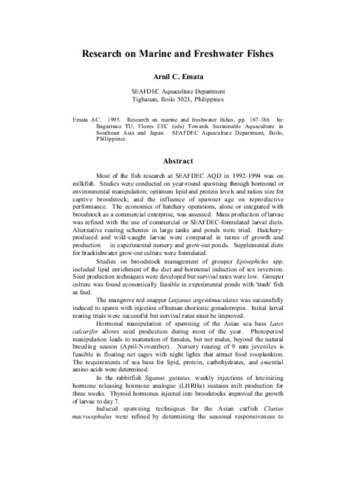Size- and weight-dependent cannibalism in hatchery-bred sea bass (Lates calcarifer Bloch)
- Global styles
- MLA
- Vancouver
- Elsevier - Harvard
- APA
- Help

View/Open
Date
1991Page views
1,553ASFA keyword
AGROVOC keyword
Taxonomic term
Metadata
Show full item recordCited times in Scopus
- Citations
- CrossRef - Citation Indexes: 39
- Scopus - Citation Indexes: 52
- Captures
- Mendeley - Readers: 23
Share
Abstract
The relationship of predator size to maximum prey size, and predator weight to weight of prey consumed among cannibalistic sea bass (Lates calcarifer Bloch) in a hatchery were assessed. Maximum prey size was computed from morphological measurements (predator mouth width, prey body depth and fish total length), while prey consumption was determined from predators kept in experimental beakers and fed only prey sea bass for a 7-day period. Maximum prey size was 61–67 % of predator total length (TLprey=0.5944TLpredator+0.0724). Gut dissection of predators showed that size of ingested prey increased with increasing predator size not exceeding the maximum size limit indicated by the above equation. Daily prey consumption of predators in the beakers was expressed as WPrey=−0.2407Wpredator2+0.7697Wpredator−0.1141. During hatchery rearing of sea bass, fish with length differences of more than 33 % must be separated and food of appropriate size provided to limit cannibalism.
Suggested Citation
Parazo, M. M., Avila, E. M., & Reyes, D. M., Jr. (1991). Size- and weight-dependent cannibalism in hatchery-bred sea bass (Lates calcarifer Bloch). Journal of Applied Ichthyology , 7(1), 1-7. https://doi.org/10.1111/j.1439-0426.1991.tb00588.x
Type
ArticleISSN
1439-0426Collections
- Journal Articles [1249]
Related items
Showing items related by title, author, creator and subject.
-
Research on marine and freshwater fishes
Emata, Arnil C. (Aquaculture Department, Southeast Asian Fisheries Development Center, 1995)Most of the fish research at SEAFDEC AQD in 1992-1994 was on milkfish. Studies were conducted on year-round spawning through hormonal or environmental manipulation; optimum lipid and protein levels and ration size for ... -
Proceedings of the Seminar-Workshop on Aquaculture Development in Southeast Asia and Prospects for Seafarming and Searanching, 19-23 August 1991, Iloilo City, Philippines
Lacanilao, F.; Coloso, Relicardo M.; Quinitio, Gerald F. (Aquaculture Department, Southeast Asian Fisheries Development Center, 1994)Documents the presentations at ADSEA '91, the 2nd Seminar-Workshop on Aquaculture Development in Southeast Asia. ADSEA '91 includes reviews of the status of the researches conducted by Southeast Asian Fisheries Development ... -
Nursery and grow-out culture of high-value fish species in sea cages
Gaitan, Albert G.; Toledo, Joebert D. (Aquaculture Department, Southeast Asian Fisheries Development Center, 2009)






